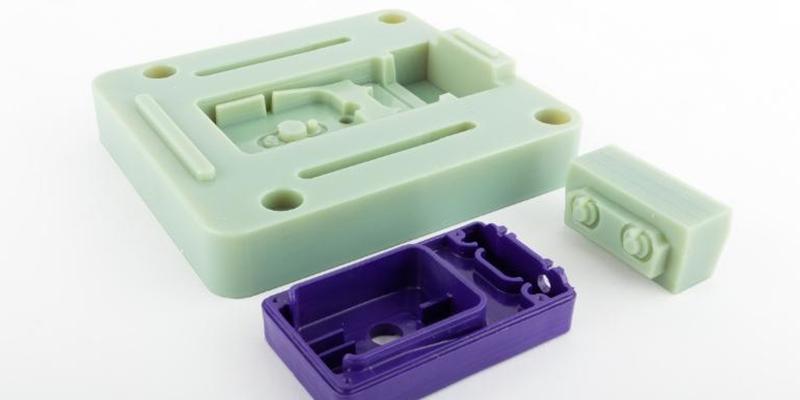- December 2, 2022
3D printed molds for injection molding are becoming increasingly popular in the manufacturing industry. It is a great addition to the injection molding process portfolio and offers a competitive alternative to traditional injection mold materials.
In this article, we will dive into what a 3D printed injection mold is and its types, benefits, and limitations. In the end, we also share some helpful tips and tricks for mold designers and engineers. Let’s begin!
What is an Injection Mold?
Injection molds are arguably the most important component in injection molding setups. The mold is a multi-part assembly with a cavity inside it that is an exact replica of the product’s final geometry.
An injection system pumps molten raw material into this cavity, where it cools down to take its final form. Afterward, an injection mechanism, which is also inside the mold, then ejects the final part. Hence, the injection mold serves the primary purpose of giving the part its shape and also ejecting it.
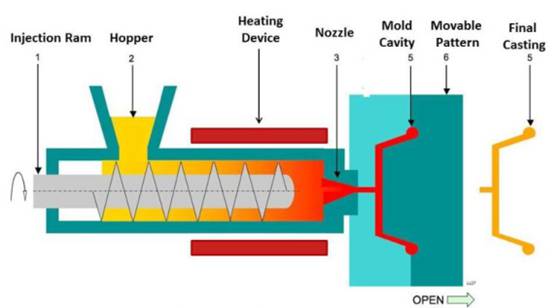
There are numerous properties that a high-quality injection mold must possess. It must have good thermal stability to minimize thermal expansion, high strength to bear the clamping pressures, and good wear resistance for durability.
3D Printing Mold vs. Aluminum Mold
Conventionally, aluminum has been the standard material choice for manufacturing low-to-medium volume production injection molds. However, 3D printed molds for injection molding are rapidly gaining traction owing to numerous benefits like cost-saving and design flexibility.
The main difference between a 3D printed mold and an aluminum mold is how they are made. The primary manufacturing process for aluminum molds is CNC machining. 3D printed molds, on the other hand, are made from 3D printing, of course.
It may seem like a trivial difference but it is, in fact, quite significant and calls for a discussion on 3D printing mold vs. aluminum mold.
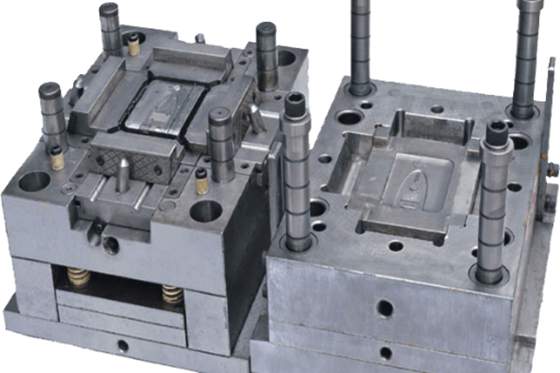
However, first, let’s go over the two main types of 3D printed injection molds.
Metal Frame Reinforced Mold
This type of injection mold borrows elements from both aluminum molds and 3D printed molds. The basic internal structure including the cavity and channels is 3D printed. This 3D print is then fit inside an aluminum structure for better stability and durability.
The aluminum frame reinforcement allows for higher molding pressures and prolongs the mold’s life. Engineers can also easily replace the 3D printed mold components in case of design changes or wear and tear.
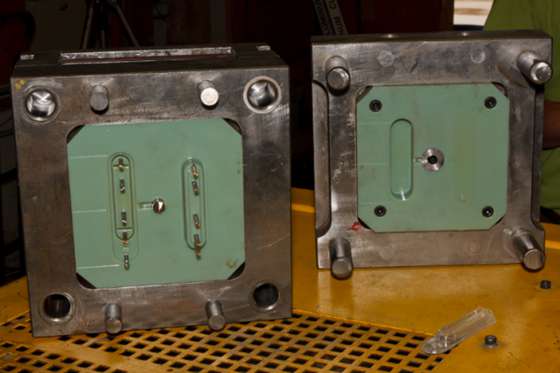
Standalone Molds
Standalone molds are made entirely by 3D printing. As 3D printing is getting more robust very quickly, standalone 3D printing mold is gaining popularity in the injection molding industry.
A major advantage of standalone molds is that engineers get additional design flexibility for features like injection channels, gates, etc.
Benefits of 3D Printed Injection Molds
3D printed molds for injection molding enjoy numerous benefits over their metallic counterparts. We will highlight some of the main advantages of using a 3D printed mold.
Cost-Effective
It is no secret that cost management is a big part of efficient manufacturing. A 3D printed mold is significantly cheaper than metal molds.
CNC machine tools are oftentimes expensive and require costly maintenance. 3D printers, on the other hand, are cheaper machines and easy to maintain. The cost of 3D printing raw materials is also lower than injection molding metals.
Labor costs also differ for both methods. CNC machines are complex equipment and require a qualified machinist to operate them. 3D printers, although not a walk in the park, are still more accessible to a wider group of technicians.
Time-Saving
Another important aspect of high manufacturing productivity is time management. A major advantage of using a 3D printed mold vs. aluminum mold is the remarkable time saving during the mold making process.
CNC machining is a time-intensive process, sometimes taking up to a week to fully manufacture a complicated injection mold. The 3D printing process is much quicker and has fewer steps than machining. The average mold-making time is in the order of a few hours, giving 3D printed molds an obvious edge.
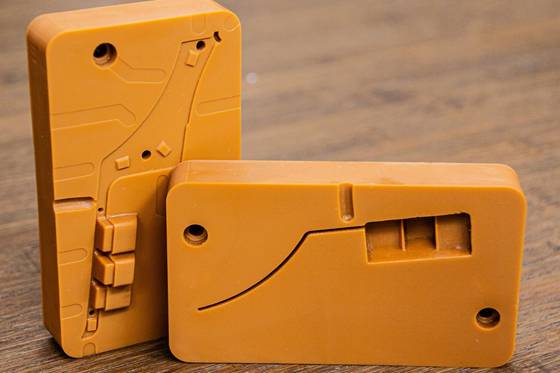
Design Flexibility
3D printing is known for its rapid prototyping capability. It is quick, cheap, and allows engineers to test various design iterations.
The same logic extends to 3D printing molds for injection molding. Mold designers can quickly eradicate any mistake or kinks in the mold design. Moreover, it is also very convenient to incorporate product improvements into the manufacturing line – all it takes is a simple reprint.
This kind of design freedom is not affordable with CNC machining, where even a single production is heavy on the budget.
Suitable for Low Volume Injection Molding
3D printed molds are well-suited to low-volume production initiatives. As we will discuss shortly, although they possess remarkable mechanical properties, they tend to wear more quickly than their metallic counterparts over time.
This makes them ideal for production runs where a small-to-medium number of parts are manufactured. In such setups, investing in an expensive metal mold is inefficient as the mold remains under-utilized at the end of the production run.
Moreover, low-volume production, on average, is more about product development and testing. The design can change midway through production if an update is required or a mistake is found. In this scenario, a 3D printing mold is ideal as updating is both cost-effective and time-saving.
Limitations of 3D Printed Injection Molds
Pros and cons go hand in hand. Therefore, this discussion will be incomplete if we ignore the drawbacks of a 3D printing injection mold.
Low Structural Integrity
3D printing is progressing very fast but it still lags behind conventional manufacturing processes like CNC machining in some aspects. It has several inherent quality issues like porosity and lack of bonding that decrease the structural integrity of 3D printed molds for injection molding.
Generally, a 3D printed mold has lower strength, hardness, and wear resistance (hence, the need for aluminum reinforcements). They tend to fail under extreme temperatures and pressures, which are sometimes necessary to achieve high-quality injection molding products.
As a result, in some cases, 3D printed molds are not a suitable substitute for cast/forged aluminum molds.
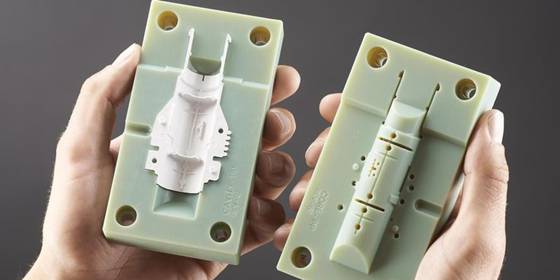
Surface Wear
3D printed molds for injection molding are not as wear-resistant as metal molds. Their surface quality deteriorates quicker than aluminum under the high temperatures and pressures of injection molding. This translates to the product’s surface as well.
In addition to this, 3D printing molds is a layer-by-layer manufacturing process. Due to this, 3D printed injection molds have a wavy surface pattern (also known as the stair-stepping effect) that increases the surface roughness of injection molding parts.
A common solution is to use surface finishing methods like filing, grinding, or chemical treatment to improve the mold’s surface quality. However, it is a challenge to perform these operations on a small mold with complex geometry, which is quite often the case with 3D printed molds.
Long Production Cycle
The cooling time comprises a big chunk of the injection molding production cycle. Since metals generally have higher thermal conductivity than the plastic materials used for 3D printed molds, it takes longer for the molten raw material to solidify when inside a 3D printed mold vs. aluminum mold.
Owing to this, we advise mold engineers to calculate the expected cooling time for their injection mold designs before deciding on the manufacturing process.
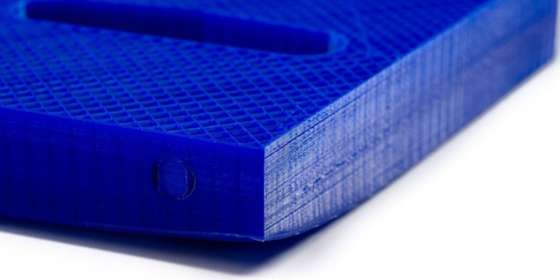
Shrinkage and Warping
Shrinkage and warping are two common 3D printing defects affecting the quality of a 3D printed injection mold. Plastics are very sensitive to heat and are prone to deforming (warping) during injection molding.
As the mold itself deforms, the shape of its cavity changes, affecting the final dimensions of the part.
In most cases, mold designers are able to mitigate this issue by incorporating appropriate shrinkage allowances in their molds. However, in the case of 3D printed molds, these allowances are hard to predict due to the non-uniform behavior of 3D printed structures.
Tips & Tricks for 3D Printed Injection Molds
We hope the above information on 3D printed injection molds for injection molding has added to your knowledge on the subject.
In this section, we will share some useful tips and tricks from our design experts that will help you improve your mold designing skills.
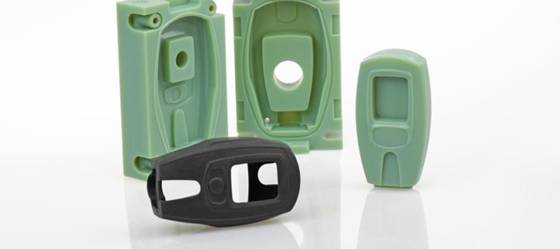
Improve Thermal Conductivity with Composition Materials
High thermal conductivity improves cooling time in injection molding. Several conductivity-boosting additives are available in the market like graphene, boron nitride, metallic fillers (copper powder, aluminum flakes), etc.
Surface Coating
Poor wear resistance is a major drawback of 3D printing molds. Appropriate surface coatings like metal or ceramics are quite useful in enhancing the surface properties of 3D printed injection molds.
Avoid Support Structures on Critical Internal Faces
Most 3D printing techniques use support structures to uphold the part during printing. They leave a mark on the part after the finishing technician removes them. Take care not to have any of these support structures on faces that form the cavity of the mold as their leftover marks will appear on the part as well.
Decrease Layer Thickness and Printing Speed for Better Surface Finish
The surface finish of a 3D printed mold depends on the layer thickness and printing speed parameters of the 3D printer. Keep these settings low to get a finer 3d printing surface finish.
Draft Angles are Slightly Higher than Aluminum Molds
3D printed structures require higher draft angles in the mold owing to their different material properties. Experts suggest including an average draft angle of 3° for the vertical faces of the injection mold.
Ventilation is Key
Air pockets tend to develop inside mold cavities and decrease surface quality. It is good to have shallow air vents slightly below the cavity surface to avoid this problem.
3D Printing Methods and Materials to Manufacture Molds
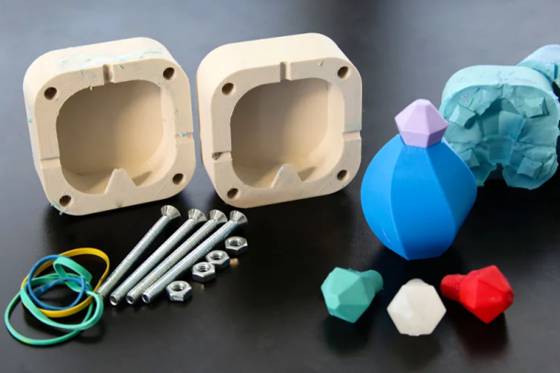
In this last section, We briefly introduce some 3D printing techniques and materials suitable for 3D printing mold.
Common 3D Printing Methods
- Stereolithography (SLA)
- Fused Deposition Modeling (FDM)
- Material Jetting
- Selective Laser Sintering (SLS)
Common 3D Printing Materials
- ABS (Acrylonitrile Butadiene Styrene)
- PETG (Polyethylene Terephthalate)
- PP (Polypropylene)
- Nylon
- Thermoplastic Elastomers (TPE)
Conclusion
This concludes our discussion on the interesting topic of 3D printed molds for injection molding. 3D printed molds are an emerging alternative to aluminum molds that offer benefits like cost- and time-saving, and design flexibility, and are great for low-volume production.
Some of their cons include low structural integrity and wear resistance when compared with metal molds, but there are specialized solutions to eradicate these issues.
Are you looking for a fast mold maker for your injection molding project? WayKen offers rapid tooling and injection molding services with strict quality control. Our advanced tooling mold and 3d printing technologies provide unparalleled accuracy and cost-effectiveness in product construction. Just contact us today, and you will get a quote and design for manufacturing analysis.
FAQs
How expensive are 3D printed molds vs. metal molds?
3D printing molds are relatively inexpensive compared to metal molds. Typically, a 3D printing mold costs under $200. A metallic mold is easily $5,000+. For a low volume setup, 3D printed molds are a clear choice.
Which common 3D printing is best for injection molds?
Comparing only FDM, SLS, and SLA, we suggest using SLA for producing injection molds. SLA products are robust, smooth, and precise. FDM molds face demolding issue and are not as smooth as SLA molds. Similar issues are commonly reported for SLS products.
How to improve the cooling time of a 3D printed injection mold?
3D printed molds do not cool down as quickly as metal molds due to their low thermal conductivity. A good tip is to use compressed air to increase convective heat transfer or you may use interchangeable stacks.

